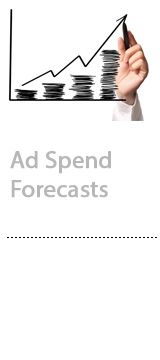
GroupM and Magna both released global advertising spend forecasts Monday with very different findings.
GroupM lowered its ad spend growth forecast for this year from 4.5% to 4.3%, reaching $543 billion. Magna, which measured 2018 in retrospect, said global ad spend grew by a record 7.2% this year to $552 billion.
GroupM revised its 2019 ad spend forecast downward from 3.9% to 3.6% to hit $563 billion. Meanwhile, Magna raised its own 2019 forecast from 4.0% to 4.7% to reach $578 billion.
Magna’s optimism for 2019 is thanks to a robust global economy and cyclical events, like the US midterm elections and World Cup, that added $6 billion of incremental ad spend to the market. GroupM, by contrast, downgraded its forecast as it anticipates a slowing economy and increasing trade tensions between the US and China in 2019. Both companies base their numbers on public media owners’ revenues as opposed to client spend.
GroupM’s and Magna’s numbers veer most on digital growth, said Vincent Letang, EVP of global market intelligence at Magna. While Magna measured 17% growth this year in digital to $251 billion, GroupM says digital will grow just 12.6% this year and 9.7% in 2019 as big clients apply more scrutiny to their investments. (GroupM did not break out dollar amounts for these growth figures.)
Magna said digital will make up half of global ad spend by 2020, but GroupM still forecasts digital’s share at 42% in 2019. Of the digital pie, Magna said search grew 16%, video 29% and social media 33% this year, while mobile ad sales grew by 32% to make up 62% of digital impressions. GroupM did not break out ad spend by format.
Facebook and Google, which still dominate roughly 70% of the digital advertising markets, buffered the impact of GDPR on global ad spend, Letang said.
“Everybody knew big platforms like Google and Facebook would be relatively immune,” he said. “It’s possible display is affected in some markets, but when you sum up all digital media formats, it doesn’t seem to dent growth.”
But the shoe might still drop on that, added Adam Smith, futures director at GroupM.
“The European Regulators are like bloodhounds,” he said. “They’re probably looking for trouble. We haven’t had a headline yet.”
As for overall client spend by sector, both Magna and GroupM saw a slowdown or flat growth in the auto and CPG sectors.
“I don’t think either of those are going to be tailwinds for advertising in 2019,” Smith said.
TV lives, out of home reborn
Magna predicts 3.4% growth for TV ad spend this year to $184 billion, while GroupM forecasts 1.2% growth in 2018 and 1.1% in 2019.
For now, advertisers in the pharma, consumer goods and automotive sectors are remaining loyal to TV despite CPM inflation and ratings erosion. Linear TV still makes up at least 50% of global spend for national consumer brands, Letang said.
“Supply is declining but demand is strong because the economy is strong,” he said. “Marketers accept that cost because business is good, and some have grown cautious about digital.”
Political ad spend prior to the midterm elections fueled TV’s growth in the US this year, which surpassed Magna’s 20% growth prediction at 30% growth. Political ad investment in September jumped by 70% over the previous midterm cycle, Letang said.
“There were a lot of narrow races and a lot of money thrown in in the late stages,” he said.
Magna’s report didn’t cover addressable TV, but previous research showed OTT spend growing 20% this year to $2 billion, and addressable TV growing 30% this year to $1 billion.
“Although TV looks like it may be eroding, there’s a great deal of innovation underneath,” Smith agreed. “But they’re not managing to capture everything that’s on the loose.”
Digital out of home is carrying growth for the traditional billboard and poster medium at 4.6% to $34 billion, according to Magna. Digital out of home itself grew 16% this year to $5.7 billion.
While the transition to digital for out of home is inevitable, it won’t be quick, Smith said.
“It might be a slow burn because there is a problem with formats and incompatibility of standards,” he said.
This post was syndicated from Ad Exchanger.


More Stories
Scroll Media boosts in-game advertising with new feature
Kiwi filmmaker spotlights media struggles at top global awards
T-Mobile Has Appointed Kristin Harrer As Senior Vice President and Chief Brand Officer